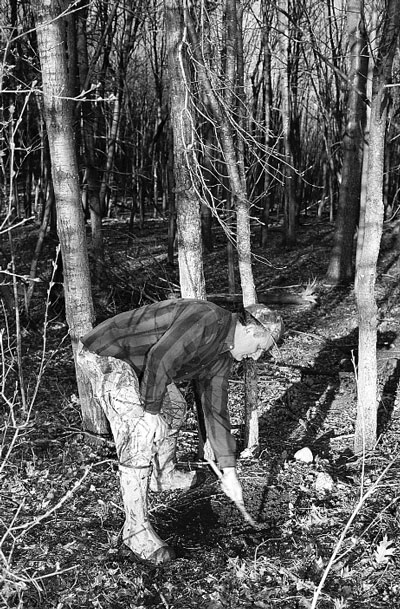 When considering whitetail bowhunting tactics, realize that even when you do everything right, there’s no guarantee of success.
When considering whitetail bowhunting tactics, realize that even when you do everything right, there’s no guarantee of success.
This is a concept that fishermen (as a group) seem to accept more than deer hunters. Across the North, for example, the muskie is known as “the fish of a thousand casts.” When it comes to killing a mature buck off a mock scrape, bowhunters may do well to adopt the same mindset.
Several factors, some of which you can’t control, must align if you’re to put a broadhead through a buck’s chest while it visits your doctored scrape. First, if you’re hunting an area that’s dominated by yearling bucks, don’t expect miracles.
“If you don’t have some big, mature bucks running around, you’ll have a hard time,” said Michigan veteran deer researcher John Ozoga. “Those little bucks really don’t know what’s going on.”
Second, realize scraping activity seldom occurs in daylight. Whether you talk to Dr. Grant Woods of Woods and Associates; Ben Koerth, a research associate at Stephen F. Austin University; or Dr. Karen Alexy Waldrop, who during her doctoral research studied scraping behavior at the University of Georgia, at least 85 percent of scrape activity monitored by research cameras occurs in darkness.
Locate on trails, staging areas
So, what to do? Waldrop research indicated that hunters are best off hunting back in the woods along trails leading to scrapes. The idea, of course, is to catch bucks approaching or leaving scrapes at the edge of day.
Also, concentrate your mock scrapes in staging areas that provide good cover near openings. Ideally, the cover will feature a dense canopy and little undergrowth, but be bordered by dense undergrowth and terrain that provides travel security.
“Deer loiter under that dense overstory, and they scrape where the understory is fairly flat and open,” Ozoga said. “You want leaf litter, no dense grass, easily exposed dirt, and little underbrush. And it must be along travel routes. The more deer activity, the better. You can’t draw deer to a scrape unless they’re going that direction anyway.”
Create a licking branch
Researchers also agree with one of Ozoga’s tenets: A scrape is nothing without a licking branch. If you find a likely site for mock scrapes, but it lacks a natural licking branch, make your own. Ozoga suggests cutting maple branches, tying them head-high or higher in a tree, and then bending them into position like a fishing pole so the branch tips are about five feet above the scrape. Or, take the branch and tie or jam it into the tree’s lower branches or crotches so its tips point straight toward the ground, much like a broken limb would hang. To finish the overhanging branch, twist or snap off the tips. Make it look like deer have been working it.
Scents help…to a point
Will doctoring mock scrapes with scents attract more bucks? Yes, but again, don’t expect miracles. Deer urinate everywhere they walk, so they constantly encounter these odors in the woods. It’s not as simple as putting out beetle or cockroach traps and watching them summon unsuspecting bugs.
Koerth’s research indicated that curiosity is what stops bucks at scrapes. Human urine, “new-car” scent spray, estrous scents and buck urine all worked equally well as attractants.
“It’s important to use scents,” Koerth said. “We had more luck getting deer to visit a scrape if we used scents. Using a scrape alone or a scent alone attracted few deer. But, essentially, all scents we tried in scrapes attracted deer. It’s important to provide visual and olfactory stimuli, almost like using magnum decoys for waterfowl.”
Ozoga, however, found that scrape visitations didn’t vary significantly whether he used water or commercial deer scents.
Scratch up fresh dirt
Woods’ findings mirrored Koerth’s. He said deer visits to mock scrapes didn’t vary whether he used deer scents, commercial ammonia, or human urine. In fact, the whitetail’s favorite odor might be the soil itself.
“When you scratch up fresh dirt, that scent lingers awhile,” Woods said. “And really, in the deer woods, freshly pawed dirt is fairly uncommon. It’s usually associated with food or scrapes. Maybe it makes them curious. The same goes for broken branches. When bucks mouth and rack that overhanging limb, they break its twigs and bark, which produces scents that linger.”
When bucks stop to examine a scrape, be prepared to shoot. If they find nothing that stimulates them, they’ll move on quickly. And chances are, you’ll never see them there again.
Besides working on a buck’s curiosity, mock scrapes can serve another important function. “If a buck does come by in daylight, a mock scrape can get him to stop,” Koerth said. “Hopefully, he’ll stop where you want him, and position him for a good shot.”






